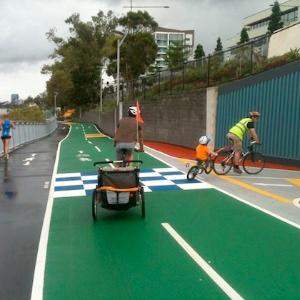Pitch
Using citizen experience to turn disconnected cycling infrastructure into a comprehensive network.
Description
Summary
The UK and many other countries have been through decades of underfunding and designing-out of cycling infrastructure. Given the reduced congestion, improved mental and physical health, and lower environmental impact resulting from cycling instead of driving efforts are now returning to facilitating cyclists. Cycle lanes are popping up and cycling is becoming more appealing. Or is it? A handful of cycle lanes does not make a cycle network. Imagine driving a car along a beautiful new road only to find it quickly turns to a dirt track. That’s what cycling in the UK often feels like. It takes time and ingenuity to retrofit a system, and to join up major pieces of new infrastructure. I see hints of work being undertaken to try and connect the routes, and to make city cycling more pleasurable. However, what I don’t see is a mass engagement with the citizens that are cycling. The users know better than anyone what makes their journey difficult, unpleasant or unsafe. Yet, engagement through inviting community-wide input is not utilised.
I believe great strides could be made by opening up to input from the public. A webpage and app where cyclists can pin a challenging point on the city map and describe problems with it. And at the same time have the opportunity to suggest solutions. This activity could be widely publicised, with a dedicated budget which will be spent on improving the highest priority locations. Solutions could be as simple as putting in a drop curb or as complex as adding in new bridges or segregated lanes.
There is a opportunity here for software to be developed which describes existing solutions for given road setups and problems. This would aid planners who are likely to be learning as they go along.
What concrete idea do you propose?
A company could look to develop software to aid city planners in retrofitting roads for cycling. This would draw on the vast array of solutions invented around the world, as well as straight-forward approaches which have been applied for decades in some countries like the Netherlands.
Such software is a useful, but not essential, precursor to local government action to draw on citizen experience. For this, the council would develop a simple website and app for people to report to. Run a campaign to advertise the website to cyclists, announcing a budget devoted to coming up with solutions. Collating the suggestions over 6 months or so. Prioritise them and agree solutions with a sample of cyclists from the city, and then implement and advertise the changes made.
This can then be repeated whenever the council has access to budget. It can also be applied to other forms of active travel, such as walking.
Who will take these actions?
It could be for a business to produce software that can be used by local governments to offer an array of solutions for given cycling infrastructure challenges. This would initially be based on existing solutions, but could also develop over time as councils come up with their own solutions. A cycling infrastructure database would be formed. Where the database can’t offer solutions, this would be fed back to the company who could offer bespoke problem-solving service, or at least provide them with information of what infrastructure to research further.
Local governments already have money to spend on cycling and they may just allocate some of this to the proposed citizen-led approach here. Alternatively, there are often grants for such work that could be bid for. These may often require the council to say what the infrastructure will be but they could instead bid for the money to implement a pilot citizen-led approach.
Impact/Benefits
What impact will these actions have on sustainability within Travel & Mobility?
In the UK, 68% of journeys taken in 2018 were under 5 miles. A majority of these are taken by car. It’s reasonable to assume that a majority of these journeys could actually be taken by bicycle (which currently makes up less than 10% of journeys). Cars over short distances are likely to be less efficient than usual at burning fuel since there is normally a lot of acceleration/deceleration at junctions, traffic jams and crossings. It is likely these journeys are undertaken in urban areas and therefore cause well-known issues of pollution and congestion. Facilitating a modal shift of these journeys from car to bicycle is integral to cities and towns improving the quality of life of residents and the efficiency of commuter travel.
Initially, the citizen-led approach proposed here will make cycling easier for those already cycling. This may increase sustainability by encouraging them to cycle more often. However, if it makes it easier for existing cyclists then it also reduces barriers to new cyclists taking up the means of travel. With many iterations of the process, more and more barriers will be removed, and a true cycling network will be formed. This will be the stage where we can expect to reach the full potential of cycling and walking journeys.
About the team members
Declan Finney is a UK climate scientist who has spent several years commuting by bike in cities. He has seen many good points and many bad, but firmly believes the UK is not a lost cause, and that it can provide a useful demonstration case of how other countries can retrofit a cycle network.
